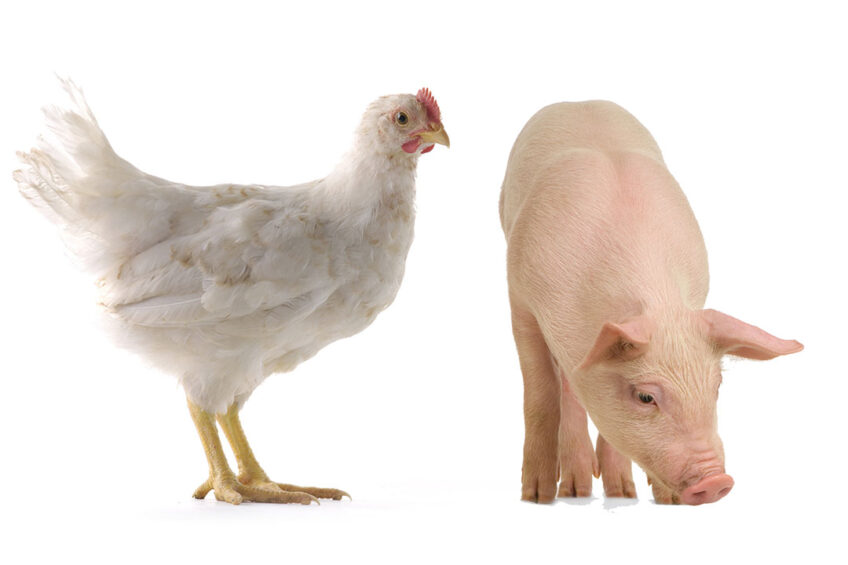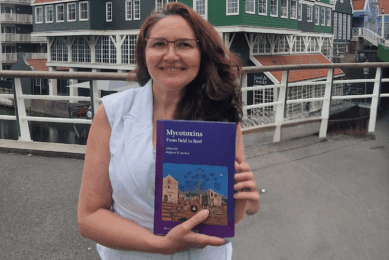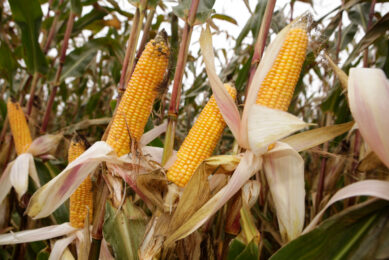The damaging effects of DON in broilers and pigs

Researchers have discovered how mycotoxin deoxynivalenol (DON) induces intestinal dysfunction and damages vital organs in broilers and pigs, leading to growth inhibition and health impairment.
MYCOTOXIN SPECIAL 2023 – read all articles
Deoxynivalenol (DON) is a common environmental and food contaminant that widely contaminates food and feed. The intestinal epithelium is the first barrier against food contaminants and is highly sensitive to DON, which is absorbed mainly in the small intestine and can damage the integrity and function of the intestine, causing intestinal inflammation. Due to the strong toxicity, DON can also damage other organs such as the liver and kidneys. As an important part of the intestinal tract, the intestinal flora is closely related to the digestion and absorption of feed and disorders of the intestinal flora are associated with some diseases. Although the toxic effects of DON have been studied previously, it is not clear whether the toxic effects of DON on different animal species are consistent. Thus, broilers and pigs, 2 main animals affected by DON exposure with different sensitivities were selected as experimental models in a study for a comprehensive analysis and comparison of the effects of DON.
The DON challenge
In an 8 week study to investigate how DON negatively impacts the growth and health of broilers and pigs – 36 male 1-day-old specific pathogen-free broiler chickens and 12 conventional white pigs were used. Broilers were challenged with DON contamination in the feed at 5 mg/kg DON (L-DON) and 10 mg/kg DON (H-DON) and pigs were only challenged with the high dosage of 10 mg/kg DON (H-DON); for both broilers and pigs, a control diet without DON contamination was included.
DON impairs growth performance
After 8 weeks of feeding, DON significantly decreased the weight gain (Table 1) of broilers and pigs. The total feed intake of broilers and pigs in the DON groups was also lower than that in the control group. In conclusion, DON induced anorexia and inhibited the growth of broilers and pigs. The depression of DON on weight gain and feed intake was 33.9% and 33.5% for broilers, and 52.6% and 38.4% for pigs. The retardation in growth was attributed to the reduction in surface area for nutrient digestion and absorption; DON led to the shortening of jejunal villi and an increase in crypt depth, resulting in a decrease in the villi/crypt ratio. DON also partially downregulated the expression of intestinal tight junction proteins, indicating that the structure and barrier function of the intestine was damaged, which was also confirmed in the functional analysis of the intestinal flora, where changes in the intestinal flora affected intestinal metabolism and digestion.
Intestinal structural damage
The study found that DON treatment led to the shortening of jejunal villi and an increase in crypt depth, resulting in a decrease in the villi/crypt ratio, in a DON dose-dependent manner. DON also partially downregulated the expression of intestinal tight junction proteins, indicating that the structure and barrier function of the intestine was damaged, which was also confirmed in the functional analysis of the intestinal flora, where changes in the intestinal flora were associated with the impairment of intestinal metabolism and digestion. The researchers also detected the content of intestinal tight junction proteins; high levels (10mg/kg) of DON significantly downregulated the expression of ZO-1 and occludin in broilers and downregulated the expression of ZO-1 in pigs, indicating that DON damages the intestinal structure and barrier function of animals.
DON alters intestinal flora
The intestinal flora is an important part of the intestine which supports nutrient digestion and utilisation and acts as a barrier to some intestinal diseases. To explore the effect of DON on the intestinal flora, the jejunum microbial 16 S rDNA of broilers and pigs was analysed; the alpha diversity of the microbial community indicated that H-DON significantly affected the diversity of both the broilers and pigs’ jejunum microbiota but with less impact on microbiota richness. However, some previous studies found that DON reduced the caecal microbial richness and diversity of broilers.
The consistent finding was that DON increased the relative abundance of Firmicutes and decreased the relative abundance of Bacteroidetes in both broilers and pigs. Most of the specific bacterial taxa in broiler intestines belonged to 3 dominant phyla, namely, Firmicutes, Proteobacteria and Bacteroidetes; and the down-regulated bacteria fell in Proteobacteria and Bacteroidetes, and the up-regulated bacteria fell in Firmicutes. In pigs, most of the specific bacterial taxa belonged to Clostridia, Bacilli and Prevotellaceae, and the relative abundance of Clostridia was increased with DON treatment, while those of Bacilli and Prevotellaceae was diminished.
It was also found that 11 bacterial taxa show opposite change trends in broilers and pigs after DON treatment, such as Streptococcaceae, Ruminococcaceae and Desulfovibrionaceae, indicating the role of DON in chickens and pigs has both similarities and differences. To further clarify the effect of DON on the intestinal function of animals, the researchers made functional predictions of the intestinal flora with PICRYst2 software; DON inhibited a variety of functions during broiler growth — mainly affected metabolic pathways, such as “amino acid metabolism”, “energy metabolism”, and “glycan biosynthesis and metabolism”.
Liver and kidney damage
The current study analysed tissues of the liver and kidney, the main detoxification organs, after DON feeding. The liver is an important organ for DON metabolism and one of the main organs damaged by DON. Urine is one of the major ways to excrete DON out of the body, therefore, the kidneys are vulnerable to DON as well. The results showed that the liver and kidney absolute weights of broilers and pigs were significantly reduced after treatment with DON. Histopathological analysis indicated that DON, especially the higher level (H-DON) can lead to inflammatory cell infiltration in liver and kidney tissue causing liver and kidney damage. To further assess the damage induced by DON, the researchers assessed some functional indexes; in broilers, H-DON increased the levels of glutathione aminotransferase, total bilirubin and uric acid, and decreased levels of albumin and triglyceride; in pigs, H-DON increased the levels of aspartate aminotransferase, total bilirubin, and creatinine 1, and decreased the levels of alkaline phosphatase and uric acid.
Concluding remarks
DON affects animal growth during early development, causing multiple organ damage and leading to disruption of the intestinal flora. Changes in the intestinal flora are related to intestinal metabolism and digestive function, suggesting that the intestinal flora is associated with intestinal dysfunction and growth inhibition induced by DON. In addition, DON has both similar and different influences on broilers and pigs. The researchers concluded: “This work will contribute to the discovery of biomarkers and antidotes for DON poisoning.”
This article is based on the original article by Bingxuan Jia, Huikang Lin, Song Yu, Na Liu, Dianzhen Yu, and Aibo Wu. 2023. Mycotoxin deoxynivalenol-induced intestinal flora disorders, dysfunction and organ damage in broilers and pigs. Journal of Hazardous Materials, 451: 131172.
Join 13,000+ subscribers
Subscribe to our newsletter to stay updated about all the need-to-know content in the dairy sector, two times a week.






